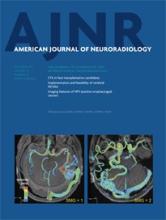Abstract
BACKGROUND AND PURPOSE: In the clinical setting, there is a need to perform mismatch measurements quickly and easily on the MR imaging scanner to determine the specific amount of treatable penumbra. The objective of this study was to quantify the agreement of the ABC/2 method with the established planimetric method.
MATERIALS AND METHODS: Patients (n = 193) were selected from the NINDS Natural History Stroke Registry if they 1) were treated with standard intravenous rtPA, 2) had a pretreatment MR imaging with evaluable DWI and PWI, and 3) had an acute ischemic stroke lesion. A rater placed the linear diameters to measure the largest DWI and MTT lesion areas in 3 perpendicular axes—A, B, and C—and then used the ABC/2 formula to calculate lesion volumes. A separate rater measured the planimetric volumes. Multiple mismatch thresholds were used, including MTT volume − DWI volume ≥50 mL versus ≥60 mL and (MTT volume − DWI volume)/MTT volume ≥20% versus MTT/DWI = 1.8.
RESULTS: Compared with the planimetric method, the ABC/2 method had high sensitivity (0.91), specificity (0.90), accuracy (0.91), PPV (0.90), and NPV (0.91) to quantify mismatch by use of the ≥50 mL definition. The Spearman correlation coefficients were 0.846 and 0.876, respectively, for the DWI and MTT measurements. The inter-rater Bland-Altman plots demonstrated 95%, 95%, and 97% agreement for the DWI, MTT, and mismatch measurements.
CONCLUSIONS: The ABC/2 method is highly reliable and accurate for quantifying the specific amount of MR imaging–determined mismatch and therefore is a potential tool to quickly calculate a treatable mismatch pattern.
ABBREVIATIONS:
- CI
- confidence interval
- IQR
- interquartile range
- NPV
- negative predictive value
- PPV
- positive predictive value
- SD
- standard deviation
- © 2013 by American Journal of Neuroradiology
Indicates open access to non-subscribers at www.ajnr.org












